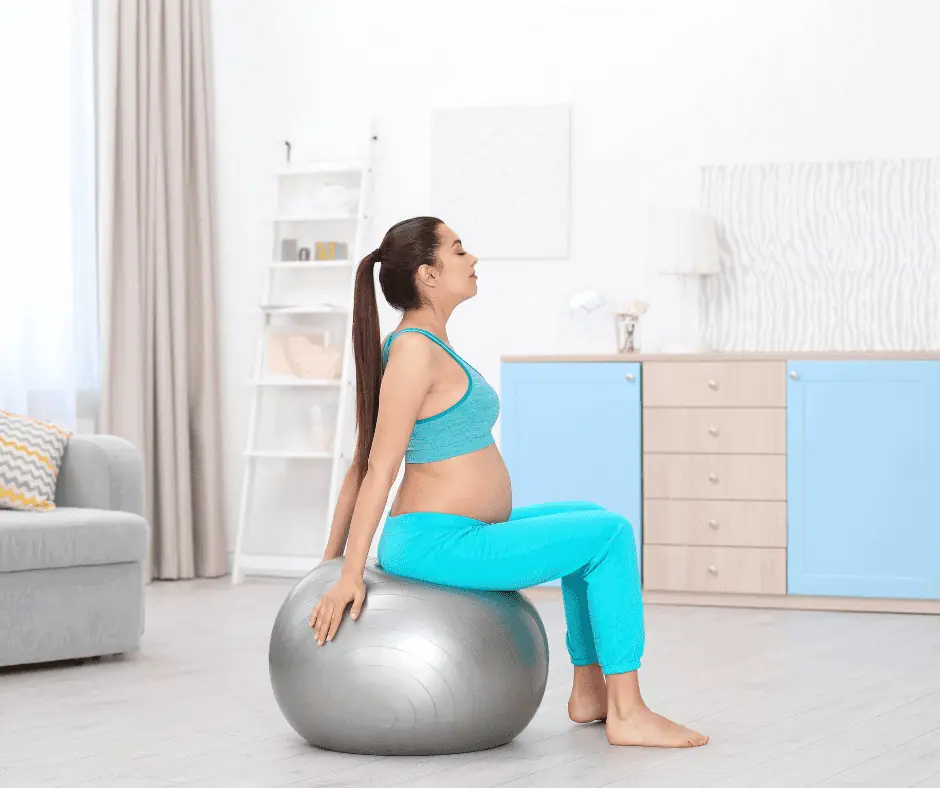Top 5 Exercises for Round Ligament Pain During Pregnancy
This post may contain affiliate links. As an Amazon Associate, I earn from qualifying purchases.
While stomach pain is common during pregnancy thanks to a growing belly and lots of shifting, new pains can also be anxiety-inducing. Round ligament pain is one type of pain that pregnant women often experience that is harmless, but super uncomfortable and can feel scary due to the sharp pains that often accompany it.
What is Round Ligament Pain?
Round ligament pain is a common cause of pregnancy pain- caused by the round ligaments stretching as your uterus grows. These ligaments support the side of the uterus and when they stretch, they can cause sharp pains or ache on either side of your lower abdomen or in your groin. The pain can last for a few seconds to a few minutes and can be triggered by certain movements like coughing, sneezing, or rolling over in bed.
For both of my pregnancies, I always had the most trouble with round ligament pain when I was trying to roll from one side to the other in bed (which was often because I was uncomfortable!).
Symptoms of Round Ligament Stretching
There are a few telltale signs that the pain you’re experiencing is due to round ligament stretching and not something more serious. These symptoms include:
- Sharp, shooting pains in your lower abdomen or groin that only last a few seconds; such as with coughing, sneezing, or changing position
- Aching on one or both sides of your lower abdomen
- Pain that is worse when you move certain ways or get up from a seated or lying down position
When to seek professional help
If you are experiencing severe pain during pregnancy that is not relieved by over-the-counter medication (that was approved by your doctor first), lasts for more than a few minutes, or is accompanied by other symptoms like fever, nausea, or vomiting then you should seek professional help.
If you’re not sure whether the pain is round ligament pain or something else, always err on the side of caution and give your doctor a call.

5 Exercises for Round Ligament Pain
There are a few simple exercises that can help ease round ligament pain. Exercise helps by promoting blood flow to overstretched and inflamed areas of the abdomen.
Ultimately, the goal during pregnancy is not to “strengthen” any core muscles- but to keep them active and extensible as your belly continues to grow.
Let’s review:
1. Pelvic Tilts
These are great for gently activating your abdominal muscles and pelvic floor muscles. Traditionally, a pelvic tilt is done lying on your back. For your comfort and safety in the second trimester or third trimester, I recommend modifying this to a seated position on a chair or yoga ball; or even standing.
- Imagine you have a tail that you will be tucking and untucking
- Lightly tighten the abdominals and pelvic floor (like you would if you were to stop the flow of urine)
- As you inhale, start to arch your lower back and press your most upper thighs into the chair or ball
- Hold for a moment (1-2 seconds)
- Exhale and switch your pelvis motion to the opposite direction, now trying to tuck your “tail” under
- Repeat 10 to 15 times as needed
- Make sure that you are keeping your upper body (neck and head) in good posture- imagine you are keeping a cup of water balanced on your head that you can’t spill throughout
2. Keeling Hip Flexor Stretch
This is a great way to release tightness in the front of your hips, which can also contribute to round ligament pain. It’s always one of my favorite stretches during pregnancy.
- Start in a kneeling position (can put a blanket or towel under the knees for comfort)
- Lunge one leg forward, keeping the back knee touching the ground
- Tuck your pelvis and press your hips forward until you feel a stretch in the front of the hip of the back leg
- If comfortable, hold for 30 seconds to one minute
- Repeat on the other side
- You should feel a stretch along the front of your thigh and possibly into your groin area
3. Cat-Cow Stretch
This is a traditional yoga stretch that is often done on all fours. It’s great for mobilizing the spine and promoting good posture to relieve general back pain as well as ligament pain in pregnancy.
- Start on your hands and knees, with your wrists directly under your shoulders and your knees directly under your hips
- As you inhale, arch your back and look up toward the ceiling (cow pose)
- As you exhale, round your back and tuck your chin to your chest (cat pose)
- Repeat this motion slowly, going as deep into each position as is comfortable
- Do not force any movement- let your breath guide you
- Perform for 30 seconds to one minute
- If you are feeling pain in your lower back or abdomen, modify or stop
4. Pigeon Pose
This is a great hip opener that can help relieve tension in the lower back and glutes and provide general abdominal relief.
- Start on your hands and knees
- Bring one leg forward, placing your shin parallel to the front edge of your mat (or where a mat would be)
- Lower your hips toward the floor, sliding your back leg straight back behind you
- You can place a block or pillow under your hip for support
- Stay here for 30 seconds to one minute, then repeat on the other side
- If you are feeling pain in your lower back or abdomen, modify or stop
- Remember to listen to your body and only do what feels comfortable
5. Side-lying
Okay, this isn’t technically a stretch. It’s a “pose” that you can take when your body needs a rest. While the body loves to move, and you should move gently as often as possible, it’s also important to recognize your limits and rest when your body needs it to! After all, you are nurturing a growing baby!
Side-lying can help relieve round ligament pain by taking the pressure off of your abdomen. It’s also a great position (or to be honest- the only position) for sleeping during pregnancy- especially on your left side.
All you need to do is find a soft spot to lie down and throw a few pillows between your legs (and maybe behind your back). Focus on letting your body relax- bonus points for deep breathing!
Round Ligament Pain: Do I need to move more or less?
If you are experiencing round ligament pain, it’s important to listen to your body. In general, gentle movements like the ones listed above can help alleviate pain by keeping things moving and mobile.
However, staying as comfortable as possible during pregnancy is definitely a delicate balancing act. On one hand, you want to rest often. On the other hand, you’ll want to take frequent breaks throughout the day from any prolonged positioning. It’s up to you to find that sweet spot 🙂
Other Pregnancy Safe Remedies for Round Ligament Pain
- Acupuncture
- Chiropractic care
- Massage (can be done by a professional or your partner!)
- Women’s health physical therapy
- Avoid sudden movements (which often causes round ligament pain)
- Brace or flex your hips prior to coughing or sneezing to reduce the chance of abdominal pain
If you choose any of these options, make sure to find a trusted healthcare provider that specifically works with pregnant women.
Your doctor may also recommend Tylenol (NOT Advil or ibuprofen) and adequate rest. In general, it is not recommended to put heat near your round ligament since this can lead to overheating of your or your growing baby.

What’s the best treatment option for round ligament pain?
Unfortunately, a lot of the discomfort and pain during pregnancy cannot only be modulated and not completely relieved. This is because of the radical changes you are going through. It can lead to tailbone pain, lower back pain, SI joint pain, sciatica, and more.
Find a physical therapist to support you in every stage of motherhood
Overall, striking a balance of movement and rest will be your best remedy. A physical therapist can help you learn how to best move your body, how to rest with good posture, and give you many other tips for improving your pain tolerance, preparing for birth, and recovering postpartum. You can make an appointment with a virtual PT or schedule a clinic appointment to get advice as soon as possible.







